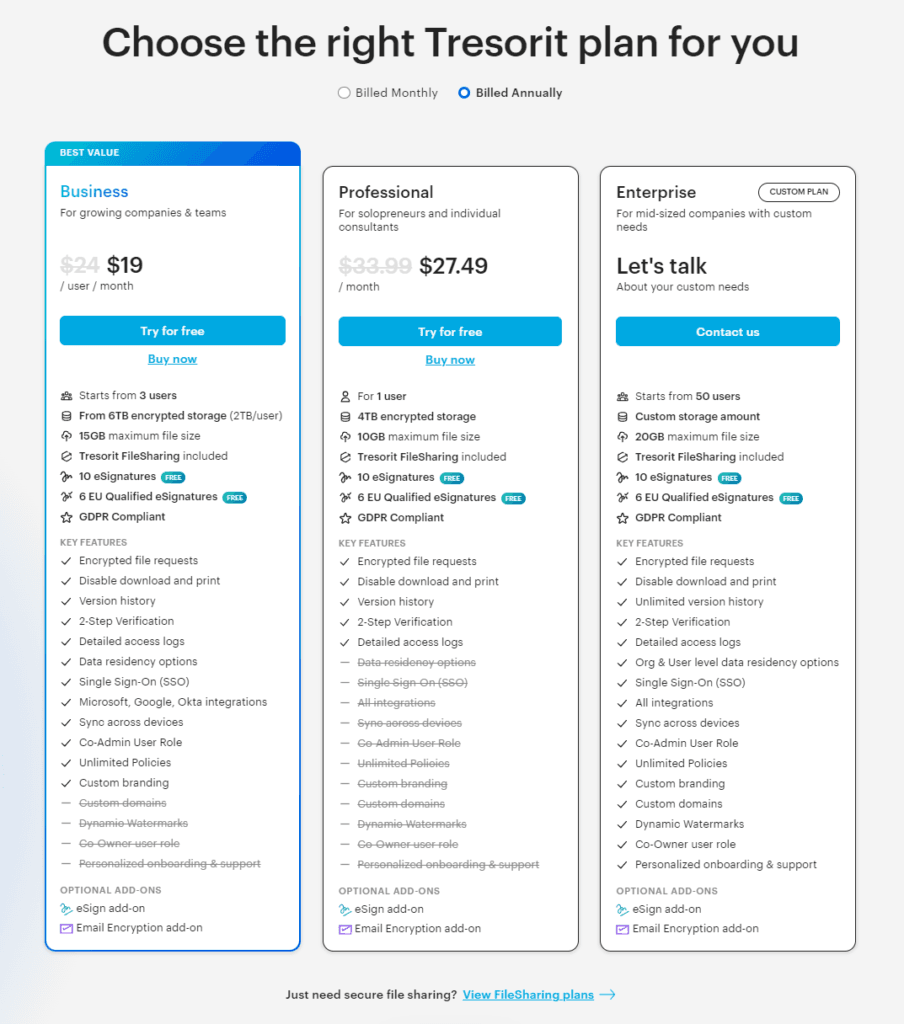Choosing the right document management tool can dramatically streamline your workflow and enhance your team’s productivity. Today, we’re comparing Tresorit and Clio, two popular options in the world of document management. Each has its strengths, particularly suited to different business needs and industries. Let’s dive into a detailed comparison to help you decide which tool might be the best fit for your operations.
| Tresorit | Clio |
|---|---|
 |  |
| G2 Score -4.5 out of 5 | G2 Score -4.6 out of 5 |
| TrustRadius Score -9.8 out of 10 | TrustRadius Score -7.0 out of 10 |
Security: Protecting Your Documents in the Digital Age
In an era where data breaches are all too common, the security of your document management system is paramount. Let’s examine how Tresorit and Clio handle security, a critical component for any business but especially for those handling sensitive or confidential information.
Tresorit’s Security Features
Tresorit is widely recognized for its robust security measures. At the heart of Tresorit’s security is end-to-end encryption, ensuring that your files are encrypted before they leave your device and remain encrypted until the intended recipient decrypts them. This process means that nobody in between, not even Tresorit, can access your data. This makes Tresorit an excellent choice for industries that handle sensitive information, such as legal, healthcare, or financial services.
Moreover, Tresorit offers advanced control over file access. Users can set specific permissions for different team members and external partners, ensuring that only authorized personnel can view or edit documents. Additionally, Tresorit includes features like remote wipe and automatic sync, adding extra layers of security for data accessed on multiple devices.
Clio’s Security Features
Clio, primarily serving legal professionals, also places a strong emphasis on security but tailors its features to meet the specific needs of law firms and legal departments. Clio offers data encryption at rest and in transit, similar to Tresorit, but does not provide end-to-end encryption by default. However, it complies with many of the same standards and regulations, such as GDPR and HIPAA, ensuring that data is handled securely.
Clio also incorporates ethical walls and permission settings, which are particularly useful in the legal environment to prevent conflicts of interest and ensure that only relevant personnel have access to certain files. Additionally, Clio offers audit trails, which provide detailed logs of who accessed what information and when, a necessary feature for compliance and security in legal practices.
Pricing: Evaluating Cost-Effectiveness and Value
The pricing structure of a document management tool is a significant factor for any business, impacting your decision based on budget constraints and the specific features you need. Let’s delve into how Tresorit and Clio structure their pricing and what each offers at various tiers to help you determine which provides better value for your organization.
Tresorit’s Pricing Structure

Tresorit positions itself as a premium document management solution, reflecting its focus on providing top-notch security features. The pricing is structured to cater to different scales of business needs, from individual professionals to large organizations. The entry-level plan offers a substantial amount of secure storage and access to Tresorit’s fundamental security features. As you move up the tiers, additional features like increased storage, advanced control options for administrators, and priority support become available.
Tresorit’s pricing can appear higher compared to some competitors, but this is justified by the high level of encryption and security measures that are unmatched in many other platforms. For businesses that handle sensitive or regulated data, investing in Tresorit’s secure environment can prevent costly data breaches and compliance issues.
Clio’s Pricing Structure

Clio’s pricing is designed with the legal industry in mind, offering features that go beyond document management to encompass complete practice management. This includes case management, time tracking, billing, and client communication tools. The entry-level option provides basic features suitable for smaller law practices, while higher tiers include more advanced functionalities that cater to larger firms with more complex needs.
Clio also offers occasional promotions and discounts for longer-term commitments, making it a potentially more affordable option for legal practices looking to integrate multiple aspects of their operations into a single platform. The comprehensive nature of Clio’s offerings can provide substantial value, especially when considering the cost and complexity of managing multiple separate tools.
Functionality: Streamlining Your Document Management
When assessing the functionality of any document management tool, understanding how it supports your daily business operations—from file management to collaboration—is crucial. Let’s delve into how Tresorit and Clio enhance productivity and cater to specific business needs through their functional capabilities.
Tresorit’s Functional Offerings
Tresorit is engineered to provide a secure and seamless document management experience, ideal for businesses that prioritize data security along with efficient file handling. The platform ensures that files are automatically synchronized across all devices, making sure that every team member has access to the latest document versions, no matter where they are. This feature is particularly useful for remote teams or individuals who need to stay productive while on the move.
Additionally, Tresorit allows users to access files offline. This flexibility means that work doesn’t have to stop when an internet connection is unreliable or unavailable; changes made offline are synced as soon as connectivity is restored. For sharing documents, Tresorit offers secure link sharing that extends beyond the platform’s users. You can send files to anyone with customizable security options such as password protection, expiration dates, and specific permissions dictating what recipients can do with the files.
Clio’s Functional Offerings
Clio, while providing robust document management capabilities, integrates these features into a broader suite of tools designed specifically for legal professionals. This integration makes Clio a powerhouse for legal practice management. It allows lawyers and legal staff to store all case-related documents in one secure, accessible location. This centralized storage simplifies document retrieval and management, crucial for legal practices dealing with large volumes of case documents.
Beyond mere document storage, Clio enhances functionality with integrated task management tools that help legal teams track deadlines and link specific tasks to cases or documents. This ensures that critical deadlines are met and that all case activities are meticulously documented. Furthermore, Clio’s integration of time tracking and billing directly with document activities facilitates streamlined invoicing processes, enabling law firms to easily bill for the time spent on document-related tasks.
User Experience: Navigating Simplicity and Efficiency
The user experience of a document management tool is pivotal as it directly impacts how intuitively team members can interact with the software, affecting overall productivity and satisfaction. Both Tresorit and Clio put a strong emphasis on creating user-friendly interfaces, but they cater to somewhat different user bases. Let’s examine how each platform approaches user experience.
Tresorit’s User Interface
Tresorit is celebrated for its sleek and straightforward interface that prioritizes user-friendliness without compromising security. The design philosophy behind Tresorit is to make advanced security features accessible and manageable for users without technical expertise. The dashboard is uncluttered, with intuitive navigation that allows users to quickly find functions such as uploading, sharing, and organizing files. This simplicity extends to its synchronization features, where files updated from one device automatically appear on all others linked to the account, making collaborative work smoother and more efficient.
Additionally, Tresorit provides a mobile application that mirrors the ease of use found on its desktop client, ensuring a seamless transition between devices. This consistency is key in maintaining productivity when away from the office, allowing users to access and manage documents securely from anywhere.
Clio’s User Interface
Clio, designed specifically for the legal industry, offers a user experience that is both comprehensive and tailored to the unique needs of legal professionals. The interface integrates various aspects of law practice management, from document handling to client communication and case management. Clio’s dashboard is structured to provide quick access to all necessary tools, helping legal teams manage their workflows efficiently.
The platform excels in how it integrates document management with other functionalities like calendaring, task management, and billing. This holistic approach means users can manage nearly all aspects of their practice without needing to switch between different applications. For law firms, this integrated user experience is invaluable, reducing the time spent navigating between systems and increasing the time available for client-focused work.
Clio also offers customization options that allow firms to tailor the interface to better suit their specific processes and preferences, a feature that is particularly useful in a field as diverse as law.
Integration Capabilities: Enhancing Workflow with External Tools
The ability of a document management system to integrate seamlessly with other applications is crucial for enhancing workflow efficiency and extending functionality. Let’s examine the integration capabilities of Tresorit and Clio, which reflect their unique user bases and core functionalities.
Tresorit’s Integration Approach
Tresorit focuses on maintaining its stronghold on security while offering essential integrations that enhance its core features. It provides seamless compatibility with Microsoft Office 365, enabling users to edit Office documents directly within Tresorit’s encrypted environment. This setup ensures that the security of documents is maintained without sacrificing the convenience of using popular productivity tools.
Additionally, Tresorit offers email integration, particularly with Outlook, allowing users to send encrypted files directly through their regular email workflow. This integration helps maintain stringent security protocols when sharing documents externally and integrates smoothly with tools that users are already familiar with.
Tresorit’s integration strategy is deliberate and focused, aiming to enhance the usability of its security features without overwhelming the user with excessive options.
Clio’s Integration Capabilities
Clio, designed as a comprehensive practice management system as well as a document management tool, extends its functionality significantly through a wide range of integrations. It is particularly aligned with tools that are staples in the legal industry. For instance, Clio integrates with legal research tools, which allows attorneys to streamline their research and case management processes under one roof.
Integration with accounting software like QuickBooks and Xero is also critical for Clio’s target users, enabling legal professionals to manage financial aspects of their practice directly within Clio. This is essential for maintaining an efficient billing cycle and financial tracking without the need to switch between different systems.
Moreover, Clio enhances team communication and collaboration by integrating with platforms such as Slack and Microsoft Teams. This connectivity ensures that communications related to cases and documents are centralized and accessible, facilitating smoother collaboration across the board.
Conclusion
Deciding between Tresorit and Clio for your document management needs comes down to understanding the specific requirements of your business and how each platform can address those needs. Both tools offer robust features designed to enhance document handling and security but cater to very different user groups. Tresorit is best suited for businesses that prioritize the security of their documents above all else. Clio, on the other hand, is tailored specifically for the legal industry. It not only manages documents securely but also integrates other crucial aspects of legal practice management, such as case management, billing, and client communications.
READ NEXT:
- Tresorit vs Bitrix24: The Best Document Management Tool for You
- Woopra vs Amplitude: The Best Analytics Tool for You
- FileHold vs Google Drive for Work: The Best Document Management Tool for You
- 21+ Top Document Management Software for Businesses: A Deep Dive
- FileHold vs Templafy: The Best Document Management Tool for You
- Confluence vs ONLYOFFICE: The Best Document Management Tool for You






















Comments are closed.